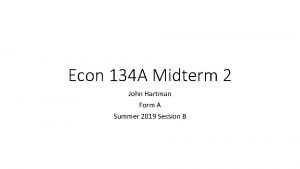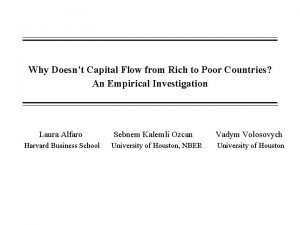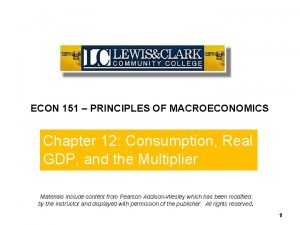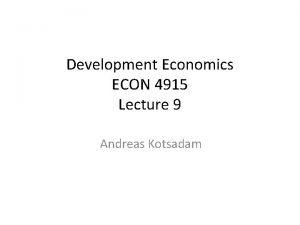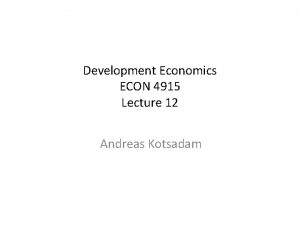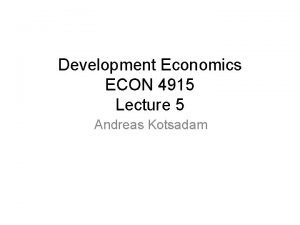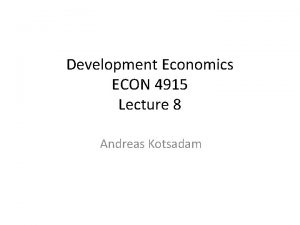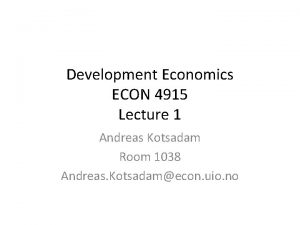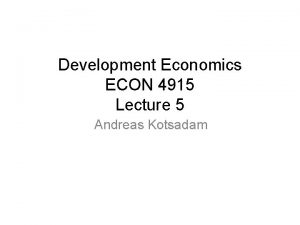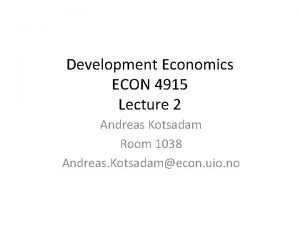Development Economics ECON 4915 Lecture 13 Andreas Kotsadam




































































- Slides: 68

Development Economics ECON 4915 Lecture 13 Andreas Kotsadam

Outline • Recap on institutions and the slave trade. • Country level and local level institutions (Michalopoulos and Papaioannou 2011). • Questions from you. • Recap, recap, and recap.

Institutions and development recap • Acemoglu et al. (2001) argue that national level institutions are key for long term development. • They test the idea by using potential settler mortality as an instrument.

Identification Strategy and argument (potential) settler mortality Settlements Early institutions Current economic performance

Glaeser et al. 2004 • Offer a forceful critique on several fronts. • They argue that the measures of institutions are bad. • And they argue that the instrument used in Acemoglu et al. is bad (settler mortality is not correlated with objective measures of institutions and the instrument is not valid).

Critique from Glaeser et al (potential) settler mortality Settlements Early institutions Human capital Current institutions Current economic performance

Nunn and Wantchekon (2009) • Historical events may be propagated by changed culture. • Example of the effects of the slave trade. • In fact, Nunn argues in another paper (2012) that the results in Glaeser er al. and Acemoglu et al. can be understood via culture: ”Rather than being two competing explanations for long-term growth, they are both part of the same evolutionary process. The confusion arises from the fact that neither paper acknowledges the role culture plays in shaping domestic institutions. ”

Michalopoulos and Papaioannou 2011 • Research question: Do institutions matter and which ones? Ø Interesting? Yes, THE QUESTION in development. ØOriginal? Yes, using nighttime light and detailed geographic information allows them to ask new questions. ØFeasible? Yes, by collecting innovative data and using RD.

Main argument • While many argue that national institutions are key, they downplay the role of pre-colonial ethnic-specific institutions. • These local institutions are particularly important in developing countries precisely because of limited state capacity.

Two questions • Do current nationwide institutions affect economic performance across regions once we account for ethnicity-specific traits, culture, and geography? • Do pre-colonial institutional ethnic characteristics correlate with regional development once we consider countryspecific attributes?

Innovations • Use a map portraying the spatial distribution of ethnicities. • Combine with data on the economy, institutions, and cultural traits of ethnic groups around colonization. • Measure regional economic development at the ethnicity-country level using satellite images of light density at night which are available at a fine level of aggregation.


The borders of Africa were drawn by these idiots at the Berlin Conference

Arguments for using the borders as an experiment • At the time of drawing the borders, the colonizers had not even explored most of Africa. • No ethnicity-specific measures can predict which ethnicities became partitioned. • There has been very few changes in borders since independence. • Compare economic performance in regions belonging to the historical homeland of the same ethnic group, but subject to different contemporary national institutions.

Same ethnic group in different countries.

Satellite light density at night • The study requires detailed data on economic development at the local level. • In addition there are problems even with cross national data, e. g. GDP (measurement; unavailability; shadow economy). • Satellite Light Density: available at every sq. km. • Strongly correlated with income and public goods provision.

Examples of what the data can tell us • If you find this interesting, see Henderson et al. (2012) ”Measuring Economic growth from outer space”. • Opens up a wide array of possible questions.

Global view

Growth on the Korean peninsula

Effects of the Asian financial crisis

Effects of the Rwandan genocide

More data stuff • They use the Ethnographic Atlas (Murdock 1967) which includes variables such as crop use, marriage patterns, local institutions etc. at the ethnicity level before colonialization. • Focus on the variable: Jurisdictional Hierarchy above the Local Community Level


Empirical specification


They also exploit the borders • They use the fact that the changes in the quality of national institutions jumps discontinuously at the border. • Across the borders, geography, natural resources, diseases etc. is equal but national institutions are not. • They check that the results are not driven by migration.

Recap Regression Discontinuity


• ”The underlying idea is that by comparing regional development in the historical homeland of the same ethnicity exactly at the border, where only the quality of national institutions differs, one accounts for all characteristics that may affect regional development. ” • Again, they find no indication of more development in areas with better national institutions.

Summary so far • “The analysis uncovers that differences in economic performance within ethnic groups partitioned across different countries cannot be explained by countrywide differences in institutional quality. While this result does not necessarily generalize to areas far from the national borders or other parts of the world, it casts doubt on the causal interpretation of the cross-country positive correlation between institutional quality and economic development in Africa. ”

What about the pre-colonial institutions? • They find a robust correlation between ethnic pre -colonial institutions (political centralization) and contemporary regional development. • “Since we do not have random assignment on ethnic institutions, this correlation does not necessarily imply causation. ” • But it is robust to control for geography at a fine level, country characteristics, and other ethnic traits.

Recap, questions from you, and exam questions

Questions from you • Credit rationing: Why is there credit rationing? Why is it worse to borrow out for consumption? • How does the instrument work in the article "Does rural bank matters? "? • What should we focus on (for the exam) when reading?

Look at your notes from lecture 2, slide 7: • Credit rationing: Ø What is it? Ø Why does it occur, in particular, why doesn’t the lender just raise the interest to lend out more? Ø Explain intuitively how information asymmetries may cause credit rationing.

Empirical strategy in Burgess and Pande (2005) • Use the imposition and removal of the 1: 4 branch licensing policy, as instruments. 1) Relevance: The policy must be a predictor for the number of banks. 2) Validity: The policy should not affect rural poverty in other ways than via the number of rural banks.

Relevance • Does the reform predict the number of banks?

Figure 1

Note that they use the trend breaks as instruments.

Exam questions on empirical papers • The questions asked and the possible theoretical mechanisms. • The empirical strategies and internal validity. • The main results, mechanisms, and external validity.

Exam questions on book chapters and theoretical papers • Given all relevant information you should be able to reproduce simple models and graphs. • You should know the relevance of the models (i. e. what do they predict and do the predictions play out in real life, do they point to important mechanisms etc. ? )

Exam questions on overview papers • These papers are often built up around questions and you should know the idea, arguments, and empirical evidence. • Examplels; Frankel (arguments and evidence for the resource curse), B&D (arguments and evidence for microfinance), O&P (arguments, measurement, and evidence for corruption) Duflo (arguments and evidence for the relation between development and gender equality).

Recap. Possible exam question • Duflo (2011) goes through the relationship between women’s empowerment and economic development. What are the possible arguments for the relationship. In particular, does development cause empowerment and does empowerment cause development?

Does development cause empowerment? • Common arguments: Ø Reduces discrimination. Ø Frees up women’s time. Ø Changes expectations. Ø Technological changes (maternal health, washing machines etc. ).

Discrimination under extreme circumstances • Girls are treated differently when ill, e. g. more than twice as likely to die of diarrhea in India. • The excessive mortality rate of girls, relative to boys, spikes during droughts. • When the harvest is bad, due to droughts or floods, and food is scarce, the murder of “witches” is twice as likely to occur as in normal years in rural Tanzania.

Policy implications • General interventions to reduce poverty may help women more. • Access to health services (health insurance or free medical care). • Weather insurance and credit.

Summary of general development • Economic development reduces inequality by relaxing the constraints poor households face, thus reducing the frequency at which they are placed in the position to make life or death choices. • By reducing the vulnerability of poor households to risk, economic development, even without specifically targeting women, disproportionately improves their well-being.

Expanding women’s opportunities • Parents have lower aspirations for their daughters than for their sons due to women’s fewer opportunities.

But economic growth is not enough • Sex ratios in China worsened despite growth. • Women earn less than men in all countries. • Legal rights are still worse for women and does not seem to follow economic development. • Huge gender gap in political participation and power.

Other crucial aspects • • • Implicit biases (See Beaman et al). Stereotype threats. Attitudes toward risk and competition. Informal care. Rigid power structures.

Does empowerment cause development? • Common arguments: Ø Effects of female education. Ø Effects of female decision making in the hh. Ø Productivity effects in agriculture. Ø Effects of female political leaders.

The effects of quotas • Beaman et al. 2009. • What do I want you to take with you from this long paper? • The question and the possible theoretical mechanisms. • The empirical strategies and internal validity. • The main results and external validity.

Should we expect quotas to change norms in women´s favor? • No, people may dislike quotas as voter choice becomes limited. • No, as quotas may violate gender norms about what women should do. • Yes, if it provides information to risk averse individuals. • Yes, if it changes perceptions about what men and women should do.

Empirical strategies • First of all they exploit random variation in quotas for female leaders in India. • Since 1993 1/3 of all councilor positions and 1/3 of all chiefs (pradhan) must be women. • These reservations were randomly allocated so identification is straightforward.

Empirical strategies • Using this random variation they investigate whether women are more likely to be elected in areas previously reserved for women. • Then they move on to investigate whether change in voter attitude is a mechanism using survey data.

Empirical strategies • Vignettes with recorded speeches are further used to get experimental variation in bias against women. • IATs were used to measure gender-occupation stereotypes as well as taste based discrimination.

Reservation makes it easier for women to become elected in later years

Several mechanisms may be at play • First, female pradhans may act as important role models and mentors. • Second, female pradhans may have also helped create and strengthen political networks that benefit women politicians. • Third, women leaders take different policy decisions. • Fourth, exposure to a female pradhan may change voter attitudes.

Results • A significant bias among men in neverreserved villages in the vignettes and reservation reverses this bias. • Both genders associate leadership activities more strongly with men in never-reserved areas and quotas reduces this association among male respondents. • No effects on taste for female leaders

To conclude • Internal validity: Clear cut. • Mechanisms: Extremely nice with experiments on experiments. • External validity: Quotas need not produce the same results in other settings. And other types of quotas!

Qian • We have gone through this paper several times. • Again, I want you to know: • The question and the possible theoretical mechanisms. • The empirical strategies and internal validity. • The main results and external validity.

Jensen and Oster • Does cable tv improve the status of women? • Son preference: “Would you like your next child to be a boy, a girl, or it doesn’t matter? ” • Domestic violence: A husband is justified in beating his wife if X, Y, Z. • Autonomy: Who decides on X, Y, Z? Need permission to X, Y? • Fertility: Currently pregnant, and birth histories.

Empirical strategy ”…relies on comparing changes in gender attitudes and behaviors between survey rounds across villages based on whether (and when) they added cable television” (p. 1059). = Difference in differences (DD).

Recap DD • Typical DD assumption: ”villages that added cable would not otherwise have changed differently than those villages that did not add cable. ”

The typical DD problem • ”… we cannot rule out with our data is that there is some important unobservable that simultaneously drives year-to-year cable introduction and year-to-year variation in our outcome measures. Although this seems unlikely, and we are unable to think of plausible examples, it is important to keep this caveat in mind. ”

They are concerned about omitted variables • “A central empirical concern is the possibility that trends in other variables (e. g. , income or “modernity”) affect both cable access and women’s status. ” (p. 1059 f). • First of all, they have to describe the factors determining which villages got cable. • Then they look closely at the timing of the effects, including testing for the effects of future cable.

Mechanisms • Why does it have an effect? Ø Provides information on birth planning? ØChange the value of time? ØMen’s leisure time is higher? ØOr, their pick: Exposure of urban lifestyles • We don’t really know. More research is needed.

External validity and data issues • Main dataset includes only hh with oldies. • Men were not interviewed, would have helped for the mechanism discussion.

Error in the paper • On page 1077 they say son preference declines by 12 pp. It should say 8. 8 as is evident in the table.
 Andreas kotsadam
Andreas kotsadam Andreas kotsadam
Andreas kotsadam čsn 014915
čsn 014915 Orhan baran fikrasi
Orhan baran fikrasi 01:640:244 lecture notes - lecture 15: plat, idah, farad
01:640:244 lecture notes - lecture 15: plat, idah, farad Principles of economics powerpoint lecture slides
Principles of economics powerpoint lecture slides Land economics lecture notes
Land economics lecture notes Health economics lecture notes
Health economics lecture notes School of business and economics maastricht
School of business and economics maastricht Mathematical vs non mathematical economics
Mathematical vs non mathematical economics What is government expenditure multiplier
What is government expenditure multiplier Fiscal policy definition
Fiscal policy definition Flipitecon
Flipitecon Econ 151
Econ 151 Mid point formula econ
Mid point formula econ Mps ap macro
Mps ap macro Marginal analysis in economics
Marginal analysis in economics Sports econ austria
Sports econ austria Econ 1410
Econ 1410 Econ 424
Econ 424 Mr darp econ
Mr darp econ What is game theory
What is game theory What is a positive analysis
What is a positive analysis Econ 134
Econ 134 Econ
Econ Econ chapter 7
Econ chapter 7 Econ muni harmonogram
Econ muni harmonogram Gertler econ
Gertler econ Why printing money causes inflation
Why printing money causes inflation Econ
Econ Econ
Econ The ak model
The ak model Nthu econ
Nthu econ Sports economics definition
Sports economics definition Econ
Econ Econ 206
Econ 206 Lorne priemaza
Lorne priemaza Econ
Econ Econ
Econ Www.econ.muni.cz
Www.econ.muni.cz Econ
Econ Econ 25
Econ 25 The fundamental cause of monopoly is
The fundamental cause of monopoly is Econ ra twitter
Econ ra twitter Econ muni
Econ muni Gdp formula
Gdp formula Econ
Econ Prime econ
Prime econ Econ
Econ Econ
Econ Econ
Econ Econ
Econ Econ
Econ Econ
Econ Econ
Econ Econ
Econ Econ
Econ Econ
Econ Yogesh uppal
Yogesh uppal Econ
Econ Kafu wong
Kafu wong Econ
Econ Econ
Econ Gertler econ
Gertler econ Nvm b econ j in m by gnbm buu kno jm m m nmh l
Nvm b econ j in m by gnbm buu kno jm m m nmh l Econ
Econ Econ 405
Econ 405 Econ 247
Econ 247 Econ 152
Econ 152























